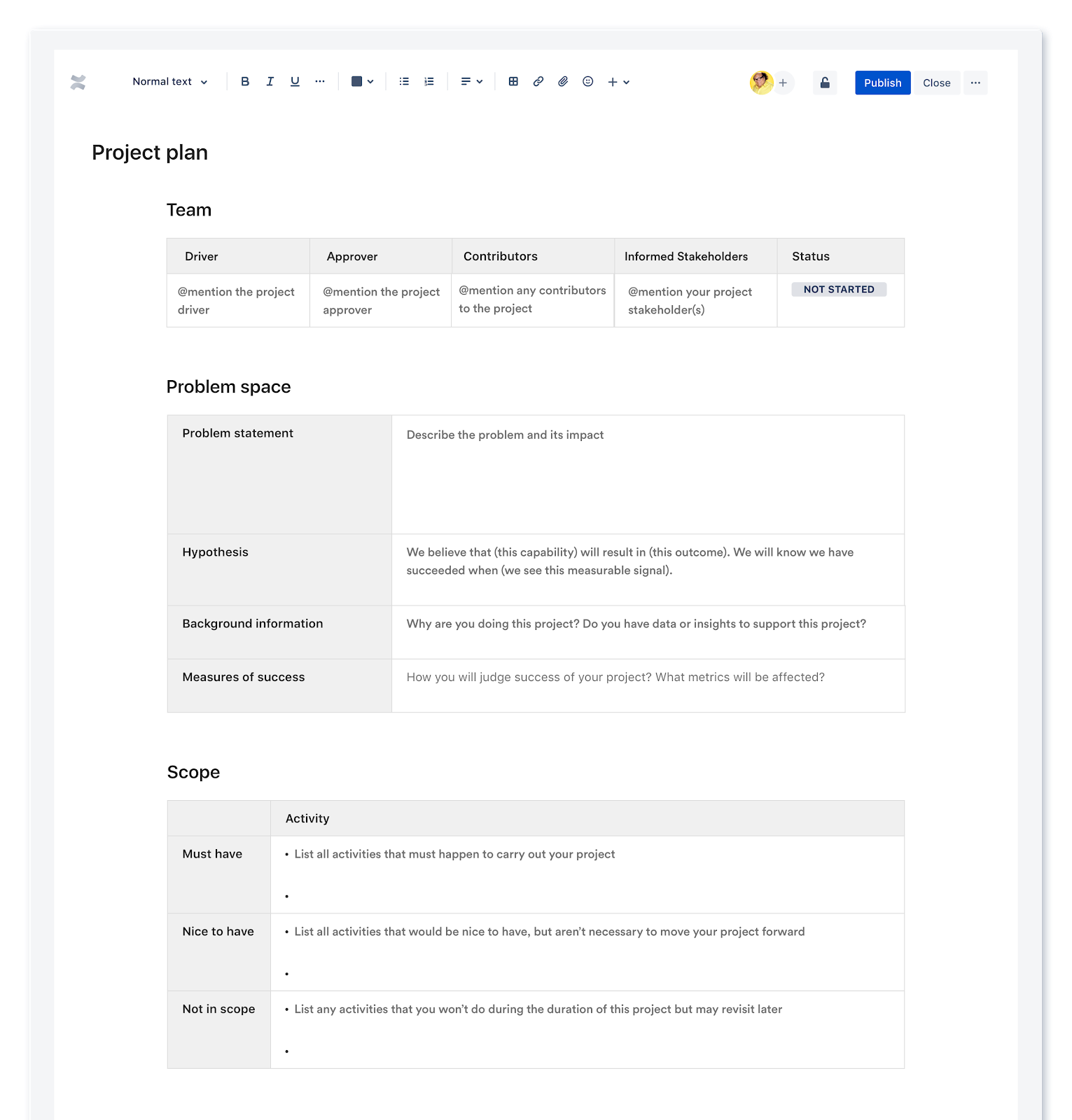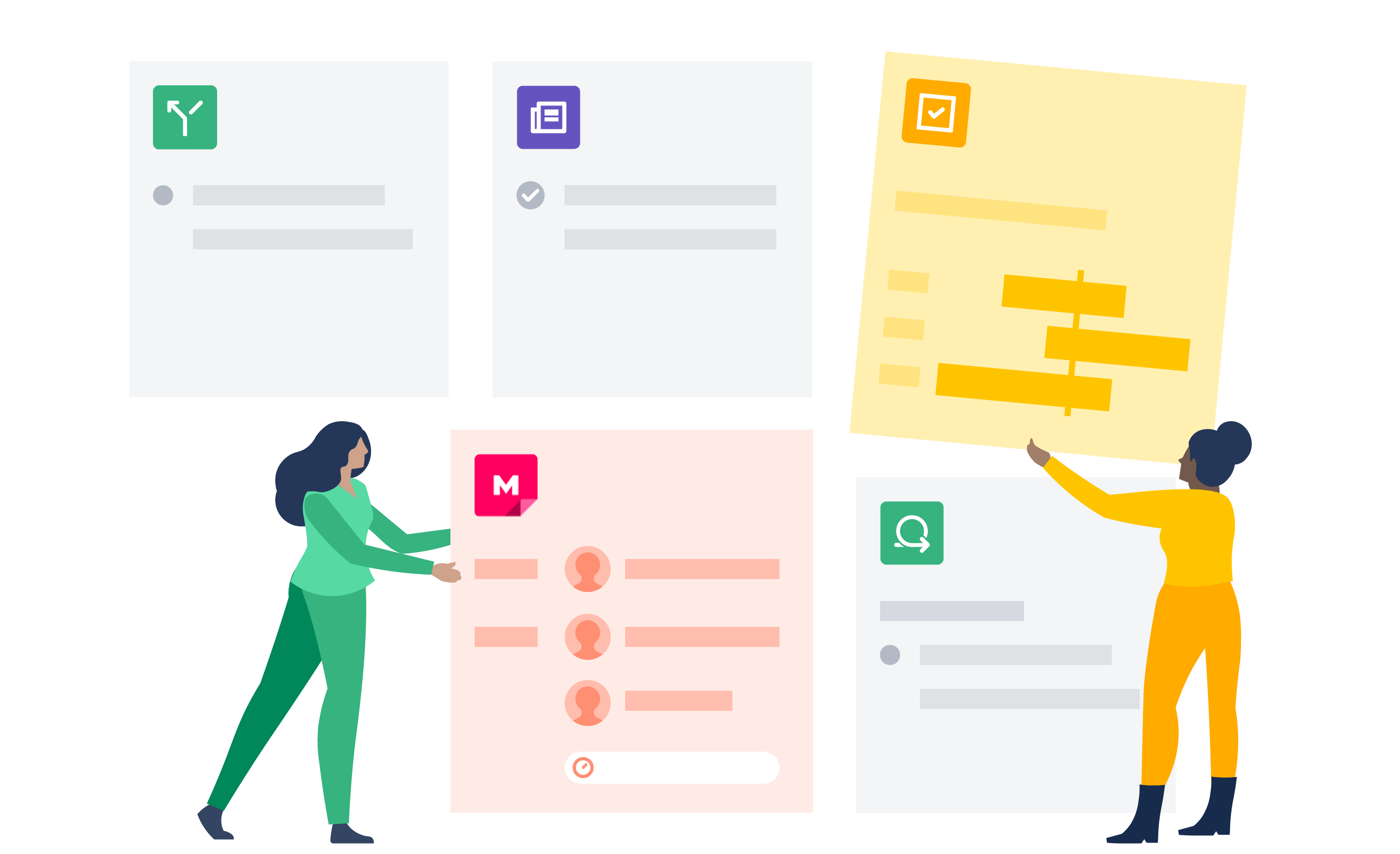프로젝트 헌장 및 프로젝트 포스터 비교: 어떤 차이가 있습니까?
주제 찾아보기
이 문서에서는 프로젝트 관리의 두 가지 필수 도구인 프로젝트 헌장과 프로젝트 포스터의 차이점을 살펴봅니다. 두 가지 모두 프로젝트 시작 및 계획을 위한 도구로 사용되지만 적용 분야에서는 상당한 차이가 있습니다. 공식적이고 정적인 문서인 프로젝트 헌장은 프로젝트의 목적, 목표 및 주요 세부 정보를 설명하는 기본 블루프린트 역할을 합니다.
반면 프로젝트 포스터는 프로젝트가 진행됨에 따라 변화하는 시각적 개요를 제공하는 동적인 도구입니다. 다음 섹션에서는 프로젝트 헌장이 프로젝트의 공식적인 기반을 마련하는 방법과 프로젝트 포스터가 프로젝트 수명 주기의 다양한 요구 사항과 단계에 맞춰 지속적인 계획과 시각화를 위한 동적인 가이드 역할을 하는 등 각각의 고유한 특징을 자세히 살펴보겠습니다.
프로젝트 헌장이란 무엇입니까?
프로젝트 헌장 혹은 브리프는 프로젝트의 목적, 목표 및 범위 설명을 요약한 개략적인 문서입니다. 프로젝트 시작을 위한 공식적인 권한 역할을 하며 프로젝트 계획 및 실행의 토대를 마련합니다. 프로젝트 헌장에는 다음과 같은 주요 정보가 포함됩니다.
- 프로젝트 제목: 프로젝트를 간략하게 설명하는 이름.
- 프로젝트 목적 또는 이유: 프로젝트의 목적과 기대 효과.
- 프로젝트 목표: 프로젝트에서 달성하려는 구체적이고 측정 가능한 목표.
- 프로젝트 범위: 구체적인 목표, 작업, 비용 및 마감 날짜를 포함한 프로젝트 요구 사항에 대한 설명.
- 프로젝트 산출물: 프로젝트에서 생산할 실적인 제품 또는 서비스.
- 프로젝트 이해 관계자: 고객, 후원자 및 팀원과 같이 프로젝트에 대한 기득권을 가진 개인 또는 그룹의 목록.
- 프로젝트 타임라인: 주요 마일스톤 및 마감 날짜를 포함한 프로젝트 일정에 대한 개괄적인 개요.
- 프로젝트 예산: 비용, 인력 및 기타 리소스를 포함하여 프로젝트를 완료하는 데 필요한 리소스 추정치.
전반적으로 프로젝트 헌장은 프로젝트의 목적, 범위 및 예상 결과에 대해 프로젝트의 모든 주요 이해 관계자와 후원자가 공통된 이해를 갖추고 합의할 수 있도록 합니다. 또한 프로젝트 관리 프로세스 전반에 걸쳐 프로젝트가 계획대로 진행되고 목표를 달성할 수 있도록 지원하는 레퍼런스 지점 역할을 합니다.
프로젝트 포스터가 왜 중요합니까?
프로젝트 헌장은 구조화된 토대와 몇 가지 구체적인 이점을 제공하여 프로젝트 관리 프로세스에서 중추적인 역할을 합니다. 첫째, 프로젝트의 목적, 목표 및 범위를 설명하여 프로젝트 팀에 명확한 방향을 제시하는 나침반 역할을 합니다. 이러한 명확성은 공동의 목표를 향한 노력을 정렬하는 데 도움이 되며 우선 순위가 서로 다를 위험을 최소화합니다. 또한 프로젝트 헌장은 잠재적인 문제와 불확실한 부분을 미리 파악하고 사전 계획과 위험 관리 전략을 지원하여 효과적인 위험 완화에 기여합니다.
게다가 프로젝트 헌장은 리소스 할당을 최적화하는 데 중요한 역할을 합니다. 작업, 비용 및 마감 날짜를 포함한 프로젝트 요구 사항을 자세히 설명함으로써 인적 및 재정적 리소스가 프로젝트의 필요에 따라 신중하게 할당되도록 합니다. 결과적으로 효율성을 높이고 리소스 병목 현상을 방지할 수 있습니다. 프로젝트 헌장의 또 다른 중요한 장점은 정보에 기반한 의사 결정을 내릴 수 있도록 지원한다는 것입니다. 프로젝트 목적, 예상 이익 및 잠재적 위험에 대한 포괄적인 이해를 갖춘 이해 관계자는 프로젝트 수명 주기 전반에 걸쳐 충분한 정보를 바탕으로 결정을 내릴 수 있습니다.
마지막으로 프로젝트 헌장은 이해 관계자 간에 합의한 내용에 대한 문서 역할을 하여 작업 증명과 책임의 근거를 제공합니다. 따라서 투명성을 높이고 프로젝트 실행 중에 발생할 수 있는 분쟁이나 오해를 해결할 수 있습니다. 요약하자면 프로젝트 헌장은 명확한 가이드, 위험 완화 전략, 최적의 리소스 할당 및 정보에 기반한 의사 결정 프레임워크를 제공하여 프로젝트 성공에 기여합니다.
프로젝트 포스터란 무엇입니까?
프로젝트 포스터는 프로젝트 매니저와 팀이 해결하려는 문제, 가능한 솔루션 및 프로젝트의 이상적인 최종 결과가 무엇인지 생각해 볼 수 있도록 해주는 프로젝트 계획 도구입니다. 프로젝트 포스터는 산발적인 활동이 아니라 프로젝트 개요 역할을 하는 문서입니다. 정적인 프로젝트 헌장과 달리 프로젝트 포스터는 프로젝트 팀이 연구 및 프로젝트 활동을 진행함에 따라 발전하고 업데이트되도록 제작되었습니다.
프로젝트 포스터는 팀이 문제를 깊이 생각하고 잠재적인 솔루션을 살펴보고 프로젝트 비전을 구체화할 수 있는 동적인 도구입니다. 이러한 지속적인 업데이트를 통해 프로젝트 포스터는 프로젝트 수명 주기 전반에 걸쳐 관련성 있고 유용한 리소스로 유지되어 프로젝트의 변화하는 특성에 적응할 수 있습니다.
프로젝트 포스터가 왜 중요합니까?
프로젝트 포스터는 팀의 프로젝트 계획이 시작되는 곳입니다. 결과적으로는 추구해야 할 솔루션, 어떤 것을 제공할 것인지에 대한 이상적인 프로젝트 비전 및 제공하기 위해 필요한 것이 무엇인지 프로젝트 위험에 대한 결론에 도달할 수 있습니다.
프로젝트 포스터는 팀이 다음을 포함한 중요한 질문에 답하는 데 도움이 됩니다.
- 어떤 문제를 다루고 있습니까?
- 왜 이 문제를 해결하는 것이 중요합니까?
- 프로젝트의 목표 및 목적이 무엇입니까?
- 무엇을 알고 있고 어떤 정보를 놓치고 있습니까?
- 가능한 해결책은 무엇입니까?
프로젝트 포스터 및 프로젝트 헌장의 차이는 무엇입니까?
프로젝트 포스터와 프로젝트 헌장에는 몇 가지 차이점이 있습니다. 프로젝트 헌장과는 달리 프로젝트 포스터는 계속 업데이트되는 문서입니다. 문제 영역을 탐색하고 가정에 이의를 제기하고 솔루션을 검증하고 피드백을 수집하고 다음 단계로 넘어가기 전에 방향을 수정하면서 업데이트할 수 있습니다.
프로젝트 포스터에는 정보를 체계화할 수 있는 세 가지 범주가 있습니다.
문제 영역: 프로젝트 개요입니다. 문제를 해결하는 것이 고객과 비즈니스에 왜 중요한지 설명하세요. 프로젝트 목표와 가능한 솔루션을 구체적으로 설명합니다.
검증: 지식 격차 및 위험을 식별하세요. 어떤 정보를 알고 있으며 무엇을 알아내야 합니까?
준비 완료: 솔루션을 시각화하고 프로젝트 계획을 구현합니다.
다음은 프로젝트 포스터의 예시입니다.
Confluence로 프로젝트 포스터를 작성하는 팁
프로젝트 성공을 위해 팀을 준비하려면 프로젝트 포스터 템플릿을 사용하여 프로젝트 포스터 플레이를 진행하세요. 프로젝트 포스터 플레이를 통해 가정을 검증하고 해결하려는 문제를 이해할 수 있습니다. 완료하면 이 간단한 공동 작업 문서에 모든 필수 프로젝트 세부 정보가 포함됩니다. 따라서 모두가 프로젝트의 컨텍스트와 비즈니스 케이스를 파악할 수 있습니다.
킥오프 세션에서는 문제를 정의하고 프로젝트 목표를 설정하세요. 그런 다음 최대한 빨리 프로젝트 후원자와 공유하여 피드백을 받고 프로젝트를 발전해 나가면서 향후 세션에 반영합니다.
프로젝트 포스터 템플릿을 사용하는 방법
Confluence 프로젝트 포스터 템플릿을 확인하세요
1단계. 기초적인 것부터 시작
쉬운 것부터 시작하세요. 템플릿의 맨 위에는 프로젝트 이름, 소유자, 팀원, 현재 상태 및 이 프로젝트가 더 큰 전략에 어떻게 들어맞는지에 대한 간략한 설명과 같은 정보를 채워 넣는 공간이 있습니다. 일반적으로 프로젝트 매니저가 프로젝트 개시자로서 이 부분을 작성합니다.
2단계. 문제 공간 정의
프로젝트의 세부 정보를 다루기 전에 해결하려는 문제를 주의 깊게 생각해 보세요. 이 프로세스는 프로젝트의 목적을 파악하는 데 도움이 됩니다.
문제가 무엇입니까? 고객 또는 프로젝트 팀원에게 어떤 영향을 줍니까? 문제가 해결되었는지 어떻게 알 수 있습니까? 당장 떠오르는 가능한 솔루션으로는 무엇이 있습니까?
이러한 유형의 질문을 곰곰이 생각해 보고 여기에 기록하세요. 이 과정은 천천히 진행하세요. 새 프로젝트를 진행하기 전에 이 섹션에 여러 번 다시 돌아올 것입니다. 더 많은 피드백과 인사이트를 수집하면서 어느 정도 조정이 필요할 수도 있습니다. 이것은 정상적이며 모두 배우는 과정의 일부입니다.
3단계. 가정을 검증 및 창의적인 아이디어 얻기
문제를 정의하면서 아마 많은 가정을 했을 것입니다. 템플릿의 다음 섹션에서는 사실과 수치를 바탕으로 가정을 테스트할 공간을 제공합니다.
여기에는 두 섹션이 있습니다. 한 섹션에는 이미 알고 있는 점을 나열하고, 나머지 섹션에는 아직 해결하지 않은 질문을 적습니다.
예를 들어 회사의 블로그 디자인을 사용자에게 더 친숙하게 바꿀 계획이라고 가정해 보겠습니다. 방문자의 56%가 한 개의 게시글을 읽은 후에 블로그를 떠난다는 점을 이미 알고 있을 수도 있습니다. 이 내용을 검증 섹션의 첫 부분에 기록할 것입니다. 하지만 방문자가 사이트에 더 오래 머물도록 하는 방법도 알아내야 합니다. 이 내용은 이 섹션의 두 번째 부분에 기록합니다.
여기서 목표는 더 진행하기 전에 브레인스톰한 솔루션의 중요한 요소를 확인하거나 반증하는 것임을 기억하세요. 아직 그럴 확신이 없다면 문제 영역으로 돌아가거나 가능한 다른 솔루션을 생각해 보세요.
4단계. 작업 실행
이 마지막 섹션에서는 작업을 본격적으로 시작하게 됩니다. 이미 문제를 정의하고 검증된 솔루션을 선택했습니다. 이 마지막 섹션을 사용하여 솔루션을 설명하고 고객이 이 솔루션을 원할 이유를 요약하세요. 메모를 추가하고 '/이미지'를 입력하여 스크린샷과 스케치를 추가하세요. 필요한 팀 규모와 같이 규모 및 프로젝트 범위를 정의할 수 있는 공간도 있습니다.
여기에서 모든 세부 정보를 논의하여 결론을 내면 주요 프로젝트 이해 관계자에게 중요한 사항에 집중하고 프로젝트가 팀원의 능력 및 역량 범위 내에 있도록 할 수 있습니다.
5단계. 참조 자료 포함
프로젝트 계획에는 해당 프로젝트와 관련된 중요한 정보가 모두 담겨 있는 것이 좋습니다. 팀원에게 필요할 수 있는 레퍼런스 자료를 포함하려면 '/링크' 명령을 사용하세요. 이 기능을 사용하면 크리에이티브 브리프 또는 예시와 같은 관련 자료를 추가하여 프로젝트 계획이 관련된 모든 이해 관계자에게 포괄적이고 쉽게 액세스할 수 있는 리소스가 되도록 할 수 있습니다.
크리에이티브 브리프든 팀원이 참조했으면 하는 예시이든 이 페이지에 모든 사항을 추가하여 체계화하고 쉽게 액세스할 수 있도록 하세요.

